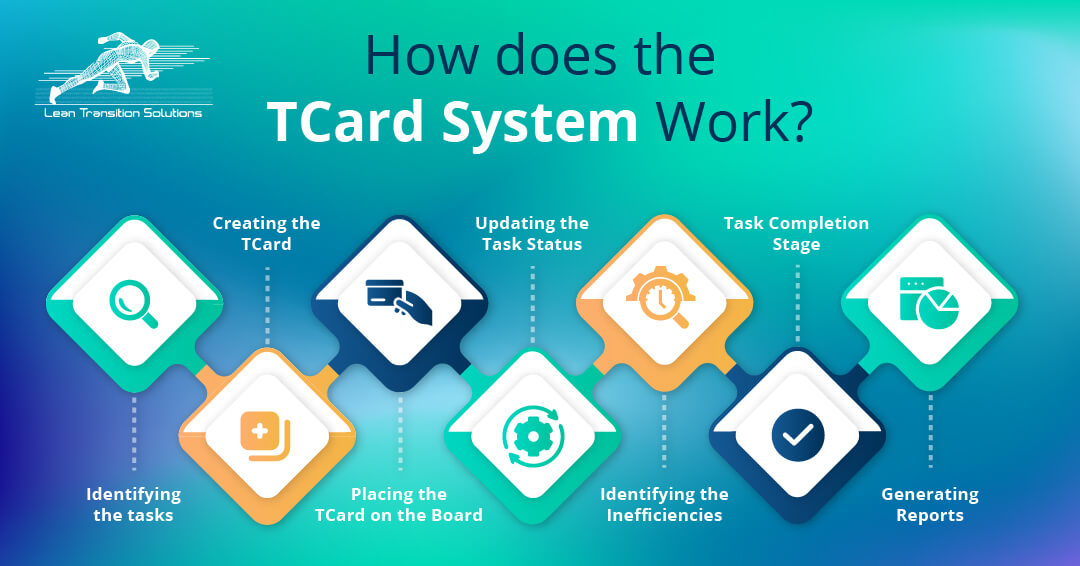How does the T-card System Work?
September 15, 2023
Is achieving seamless workflow management proving to be a challenge in your organisation? Optimising workflow is a crucial process focussed by industries to attain organisational success. Streamlining workflows enhances the overall process, ensuring tasks are completed promptly and efficiently. This leads to higher customer satisfaction and enables companies to respond quickly to market changes and innovations.
The T-card system simplifies workflow with real-time task visibility, drag-and-drop scheduling, and assigning tasks to responsible individuals. In this blog, let's understand the T card system and how it works within an organisation.
What is the T-Card System?
The physical T-card system is used in industries to optimise workflow management and is often recognised as a precursor of its digital version. It consists of T-shaped cards placed on T-boards or racks containing details of task items, responsible individuals, work orders, and task frequency. The T-cards are placed in a way that allows easy visibility of the card headings. As work progresses, the T-cards are moved across the board to track the task statuses visually. The T-card system is a simple yet effective way to facilitate hassle-free workflow management and is widely used across various industries.
The TCard system comprises several components that collectively facilitate efficient task prioritisation and workflow management.
- T-Cards: T-cards themselves are the central elements of the system. They hold essential task information and are typically colour-coded or labelled for easy identification. Each T card contains critical details such as task descriptions, deadlines, priorities, frequencies and assigned team members, ensuring clarity and accountability.
- T-Card Boards: T-card boards are essential components of the visual planning system. They consist of tracker racks that serve as the framework for the system. There are two types of tracker racks - Tcard racks and tcard strips. The tcard strip is an individual column containing slots, while the tcard rack is a group of tcard strips held together by support at the top and bottom. Each board is divided into columns that represent individual tasks, and the tcards are organised in the racks based on the schedule by which the tasks are to be completed. The top part of the Tcard, which contains the key information, is visible on the board, while the body of the card fits into the slot.
What is a Digital T Card system?
A digital T-card system is a software-based solution designed to replicate the functionality of physical T-cards in a digital platform. It serves as a visual workflow management tool, allowing teams to manage tasks, work orders, or items using virtual cards on a digital board. Each digital card represents a specific task or item, and team members can move these cards in real time across the digital board to indicate progress and status.
Choosing a digital T-card system over a physical T-card system offers several advantages that can significantly enhance productivity and flexibility in modern work environments. Firstly, digital T-cards eliminate the limitations associated with physical boards and cards, such as manual data entry, manual updates, the inability to collaborate remotely and room-to-store physical cards. With digital T-cards, teams can collaborate seamlessly, regardless of physical location, enabling remote work and real-time updates.
Furthermore, digital T-cards provide enhanced data analytics and reporting capabilities. They can capture and analyse historical data, offering valuable insights into workflow patterns, bottlenecks, and process improvements. This data-driven approach allows organisations to make more informed decisions and continuously optimise their processes.
The Digital T-card system often integrates with other project management and workflow tools, enabling seamless coordination with task lists, calendars, and document repositories. This integration enhances efficiency and streamlines the overall work management process.
Features of a Digital T Card System includes:
- Real-time Accessibility and Updates: Access and update tasks and workflows from anywhere, facilitating remote and distributed team collaboration.
- Enhanced Data Security: Implement user permissions and encryption to protect sensitive information.
- Scalability: Easily handle a large volume of tasks and items without physical space constraints.
- Reporting and Analytics: Generate reports and gain valuable insights into workflow efficiency and productivity.
- Card Customisation: Tailor workflows, fields, and labels to meet specific organisational needs.
- Integration with existing systems: Seamlessly integrate with other project management and productivity tools.
- Get Real Time Notifications: Receive timely alerts and notifications for task updates and deadlines
- Streamlined Workflow Management: Simplify task tracking and optimise workflow processes efficiently.
How does the T card System work?
A physical T-card system works by using physical cards, typically shaped like the letter "T," to represent tasks, work orders, or items in a visual management process. These cards are placed on a physical board in a designated area. Team members move the cards across the board to indicate the status and progress of each task or item. It visually represents workflow, allowing teams to track work, prioritise tasks, and communicate effectively about ongoing activities.
Now Let’s understand how a digital T-card system works through a step-by-step breakdown:
Step 1: Identifying the tasks
The process begins with identifying the task that needs to be managed in the operation. This could be a manufacturing task, a project assignment, or any operation that needs tracking and management.
Step 2: Creating the T-Card
Once the task is identified, a corresponding T-Card is created. The TCard includes task details such as a brief description, due date, assigned team member, and relevant notes.
Step 3: Placing the T-Card on the Board
The newly created T-Card is placed on the T-Card board, usually categorised by department, project, or workflow stage, depending on the organisation's needs. This visually represents the task's initial stage.
Step 4: Updating the Task Status
As the task progresses, the T-Card moves through the board's sections, reflecting its status changes. Colour-coding on the T-Card indicates its priority level, with different colours signifying various levels of importance.
Step 5: Identifying the Inefficiencies
If inefficiencies or delays occur at any point in the process, they are noted on the T-Card. This could involve marking it with a specific colour to indicate the issue.
Step 6: Task Completion Stage
When the task is completed, a final status indicator is placed on the T-Card, often using a designated colour to signify task completion.
Step 7: Generating Reports
After task completion, the T-Card can be used for reporting and analysis purposes. Teams can generate reports to analyse the overall workflow, identify trends, and make improvements based on the historical data collected through the T-Cards.
Benefits of Implementing a Digital T Card System in your organisation
- Visual Task Representation: TCards visually represent tasks, making it easy for teams to see the entire workflow at a glance. This visual approach simplifies task tracking and status assessment.
- Task Prioritisation: T-Cards are colour-coded or marked to indicate task priorities, allowing for efficient resource allocation and timely completion of scheduled tasks.
- Transparency and Accountability: The system provides transparency into task ownership and progress, holding team members accountable for their assigned tasks. It's clear who is responsible for each action item.
- Workflow Optimisation: TCard boards or racks enable teams to visualise the entire workflow. Organisations can identify inefficiencies and implement workflow improvements by monitoring the flow of TCards through the system.
- Task Tracking: The TCard system offers a structured way to track the progress of tasks, preventing them from falling through the cracks and ensuring they move through workflow stages efficiently.
- Efficient Resource Management: Organisations can allocate resources more efficiently by visualising task priorities and workloads. Critical tasks receive the necessary attention and resources for successful completion.
T-Card System Applications
Let's look at a few examples of digital T-cards in action. T-card systems can help organise tasks, manage projects, and track progress in any industrial set-up due to their versatility and adaptability.
- Manufacturing and Lean Production: TCard systems are extensively used in manufacturing to streamline production processes, improve resource allocation, and reduce waste through lean principles.
- Project Management: They are an invaluable tool for project managers to assign tasks, monitor progress, and ensure project milestones are met efficiently.
- Healthcare and Pharma Sector: In healthcare settings, TCard systems enhance patient scheduling, staff assignments, and resource allocation, leading to better patient care and efficient clinic or hospital operations.
- Automotive Sector: TCard systems streamline operations in the automotive industry by managing tasks related to production, supply chain, maintenance, and quality control, ensuring smoother manufacturing processes.
5 Key Considerations while Implementing T card Systems
1. Alignment with Organisational Needs
Ensure the T-Card system aligns with your organisation's specific goals and objectives.
2. Change Management and Training
Address change management early, as employees may need time to adapt to the new system. Providing comprehensive training and support ensures smooth adoption and maximises user proficiency.
3. Data Security and Privacy
Prioritise data security and privacy, while implementing a digital T-Card system. Implement robust cybersecurity measures to protect sensitive information and ensure compliance with relevant regulations.
4. Integration with Existing Systems
Consider how the T-Card system will integrate with your existing tools and processes. Seamless integration can enhance productivity and reduce potential disruptions during implementation.
5. Scalability and Technical Support
Plan for scalability to accommodate future growth and increased usage of the T-Card system. Additionally, ensure access to reliable technical support to address any issues or challenges arising during implementation and daily use.
The T-Card system is a powerful and intuitive solution for enhancing organisational task management and workflow optimisation. It is a simple yet effective approach, leveraging visual cues and task prioritisation, empowers teams to achieve greater efficiency, transparency, and accountability in their operations. As we've explored the mechanics of how the T-Card system works, it's evident that this tool transcends industry boundaries, finding applications in manufacturing, project management, healthcare, and beyond.
The T card system is a versatile asset that streamlines operations and boosts productivity for organisations. By embracing the T-Card system, businesses can transform their work processes, ensuring tasks are not just completed but completed efficiently and effectively. Manufacturers should consider implementing the T-Card system to elevate their operations, deliver quality products, and stay ahead of the curve in today's fast-paced industrial landscape.
